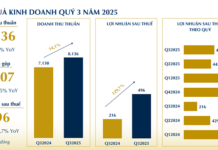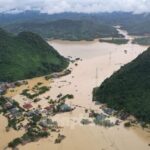According to the Ministry of Industry and Trade, the water level of Thác Bà Lake has decreased to 58.97 meters, a reduction of approximately one meter from its peak. The inflow to the lake is currently 1,984 cubic meters per second, which is less than the discharge capacity, resulting in a declining water level.
Water levels on the Thao River in Lao Cai are below the warning level and receding; at Bảo Hà, it is also below the warning level and falling. In Yên Bái, the river level is at 30.42 meters, surpassing the warning level but on a downward trend.
The Hồng River in Hanoi stands at 10.16 meters, below the second warning level and receding. Further downstream in Hải Dương (Phả Lại), the river level is at 6.10 meters, above the third warning level but also decreasing. In Thái Bình (Quyết Chiến) and Nam Định (Nam Định), the river levels are at 5.30 meters and 4.94 meters, respectively, both above the third warning level but on a downward trajectory.
In Hà Nam (Phủ Lý), the river level is at 5.21 meters, above the third warning level and falling. Similarly, in Ninh Bình and Hưng Yên, the river levels are at 4.0 meters and 6.99 meters, respectively, with Ninh Bình above the third warning level and Hưng Yên below it, both showing a decreasing trend.
The Cầu River in Thái Nguyên (Chã) and Bắc Ninh (Đáp Cầu) has risen above the third warning level, with levels at 10.01 meters and 7.70 meters, respectively, but is now receding.
Speaking to Tiền Phong on September 12, the leadership of Thác Bà Hydropower Company assured that the plant is operating safely. The inflow to the lake has decreased, and regular inspections of the dam, machinery, and embankments are being conducted. Other hydropower plants, including Lai Châu, Sơn La, Hòa Bình, and Tuyên Quang, have also significantly reduced their discharges.

Electricity workers repairing power lines after the flood.
Mr. Nguyễn Mạnh Cường, Deputy General Director of Thác Bà Hydropower Company, stated that the situation has improved compared to previous days, with a reduction of 3 centimeters in water levels per hour. As of 5 PM on September 12, the inflow was 2,100 cubic meters per second, and the discharge had significantly decreased from the previous day to 2,778 cubic meters per second. Compared to the same time on the previous day, the inflow has dropped by more than 1,200 cubic meters per second, and the plant’s discharge has been reduced by 386 cubic meters per second.
With the continuing decrease in inflow, the lake’s upstream water level has dropped by almost half a meter in the last 24 hours, now standing at 59.43 meters. The Thác Bà reservoir is following the order to open 3 out of 3 floodgates, as directed by the Ministry of Agriculture and Rural Development.
“If it doesn’t rain, the lake’s water level drops by 3 centimeters per hour,” said Mr. Cường. “In the event of heavy rainfall upstream, the inflow will increase, and the water level will decrease more slowly. We regularly inspect the auxiliaries, equipment, and spillways to ensure safety.”
According to Mr. Cường, the Thác Bà Hydropower reservoir is currently safe, according to the assessment of the competent authorities. They continue to monitor the flow closely and prepare for various flood discharge scenarios and emergency responses (if necessary) to ensure the safety of the project and the downstream area.
Mr. Vũ Văn Tinh, Director of Tuyên Quang Hydropower Company, shared with Tiền Phong that from the beginning of June to now, there have been nine floods entering the Tuyên Quang Hydropower reservoir, including one extremely large flood, three large floods, and the rest being small and medium-sized floods. The total water volume in the flood after Storm No. 3, as of 9 AM on September 11, was 1,302.8 million cubic meters. The company has strictly complied with ten official dispatches from the Ministry of Agriculture and Rural Development ordering the opening and closing of the spillways, with the highest discharge during this period being 5,656 cubic meters per second.
“Since its operation, this is the first time that the Tuyên Quang reservoir has opened eight spillway gates. Previously, in November 2008, the Tuyên Quang reservoir opened 5.5 spillway gates + maximum power generation of 2 turbine units to ensure the safety of the project with a maximum discharge of 3,900 cubic meters per second. Currently, the inflow to the Tuyên Quang reservoir is decreasing gradually. In this flood, as of 9 AM on September 11, the Tuyên Quang Hydropower reservoir has contributed to flood control with a volume of 305 million cubic meters,” said Mr. Tinh.
According to the latest data from the Vietnam Electricity Group (EVN), the inflow to the Tuyên Quang reservoir at 5 PM on September 12 continued to decrease significantly compared to the previous day, reaching 1,839 cubic meters per second, with a discharge of 1,836 cubic meters per second. Thus, within just one day, the inflow to the reservoir decreased by nearly 1,100 cubic meters per second. The plant also reduced its discharge by more than 2,000 cubic meters per second compared to the previous day. The upstream water level of the reservoir recorded a slight decrease in inflow within the last 24 hours, currently at 117.3 meters, and is expected to continue declining in the coming hours. The plant has closed five spillway gates, leaving only three open as of September 10-11.
At Hòa Bình Hydropower Plant, the inflow has decreased to 1,227 cubic meters per second, and the total discharge through the plant has been reduced to 1,770 cubic meters per second. The upstream water level of Hòa Bình Lake has risen by half a meter, reaching a height of 112.34 meters.
The Sơn La reservoir is receiving an inflow of 3,088 cubic meters per second, with a discharge of 2,532 cubic meters per second through the plant. Hydropower plants in the Northwest region, such as Lai Châu, Bản Chát, and Huội Quảng, are maintaining discharges of 1,652 cubic meters per second, 316 cubic meters per second, and 469 cubic meters per second, respectively. Two large hydropower plants in North-Central Vietnam, Trung Sơn and Bản Vẽ, are discharging at 1,415 cubic meters per second and 1,446 cubic meters per second, respectively.
The Rising Waters of Buoi and Hoat Rivers: Thanh Hoa Urgently Reinforces Dikes, Prepares to Evacuate 3,000 Residents.
On the morning of September 13, the Buoi and Hoat rivers continued to swell, prompting authorities in Thanh Hoa province to remain on high alert and take necessary measures to ensure the safety of the local populace.
The Thac Ba Hydropower Plant is Safe, Lakes Reduce Flood Discharge
Speaking to Tien Phong Newspaper, leaders of the Thac Ba Hydropower Company assured that the plant has been operating safely. Inflow to the reservoir has decreased, and regular inspections of the dam, embankments, and machinery are being conducted. Other hydropower plants, including Lai Chau, Son La, Hoa Binh, and Tuyen Quang, have also significantly reduced their discharge rates compared to the previous day.












































